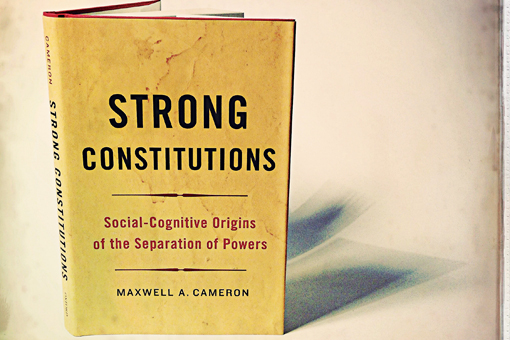Power appears strongest when it is centralized and unified, so the idea that political power is most efficiently exercised when it is divided among different branches of government is somewhat counterintuitive. Yet, in his book on political theory, Strong Constitutions: Social-Cognitive Origins of the Separation of Powers, Maxwell Cameron argues that dividing power is a basic tenet of constitutional government and modern liberal democracy.
Most democracies delegate separate but equal functions to different branches of government: parliaments or legislative assemblies make laws; judges interpret and apply the laws; and the executive enforces them. These are commonly ascribed to legal doctrine, but Cameron invites us to think about this type of political organization in a different way, by tracing it to the evolution of communication and its impact on social- cognitive change.
Cameron identifies the origins of the idea of separation of powers with the spread of literacy, the Gutenberg revolution, and the industrial and electronic revolutions that brought about mass politics, and with it the spread of literacy and the evolution of institutional design. Turning to Latin America, he connects the spread of print culture in eighteenth-century Mexico to the formation of public opinion and a growing sense of nationalism that led to the independence movement. After independence, the spread of the press in Mexico City, Lima, Buenos Aires, and in other major Latin American cities went hand-in-hand with the adoption of written constitutions, support for freedom of the press, and recognition of the need for educational reform.
Building on selected classical (Aristotle, Montesquieu) and contemporary (Habermas) political theory, Cameron focuses on the role played by language and communication in the choice of mechanisms providing for the enforcement of the law— an essential ingredient to generate “collectively desired outcomes.” As he observes, a person without cognitive abilities cannot deliberate or measure the consequences of his or her actions. Moreover, someone incapable of deliberating cannot exercise moral judgment.
It follows therefore that the key to an individual’s capacity for deliberation, execution and judgment is the ability to communicate—hence the relevance of language.
The role of written language, he concludes, is crucial in making the jump from deliberation to coordinated collective action. Through writing, theories that criticize and challenge power are legitimized.
There is an intimate connection between written texts and constitutions. Cameron suggests that the advent of reading and writing, by making it possible to create written constitutions and legal codes, enabled long-term institutional arrangements and an enduring constitutional order. Thus, a major focus of Cameron’s book is the role played by written constitutions in coordinating collective action and establishing the framework for the creation, interpretation and application of written rules or norms whose enforcement is backed by legally sanctioned coercion.
Implicit in Cameron’s insight is the realization that, in thinking about the separation of powers, it is critical to understand that each of the three branches of government relies on constitutional texts to act within the framework of the law. While a constitution may, for example, prescribe respect for human rights or affirm the principle of civilian control over the armed forces, these principles are not worth the paper they are written on without separation of powers.
“A constitution that does not separate the branches of government is not a constitution any more than a promise is made every time someone says ‘I promise’…” writes Cameron.
The most useful element of Cameron’s “social-cognitive theory” of separation of powers, therefore, is that placing language and communication at the center of analysis helps avoid false and artificial assumptions about what makes a constitution genuinely “strong.”
“Constitutions involve linguistically constructed worlds of shared meaning,” explains Cameron. Put another way, they seek to regulate and settle problems of political order. But constitutional clauses are open to a wide range of interpretations, and different arguments may result in open confrontation between the branches of government. If only one branch of government could decide which rule to enact, what course of action to pursue and whether its own acts are legal, the result is unlikely to enhance the security of citizens or the ability of the government as a whole to operate democratically.
Beyond Cameron’s well-structured theory of separation of powers and the significant role it plays in political theory, one is left with the impression that the book’s emphasis on the interpretation and application of constitutional texts in a modern democracy rests not so much on clarifying the formal borderlines of each branch of government, but rather on the ability of major political forces to agree on what a constitution means and how it applies to their actions.
Today in the Americas, however, the argument that strong government is divided government and the need for that to be based on shared language and meaning is a sharp and unfortunate contrast to the current politics in many countries, including the U.S.





